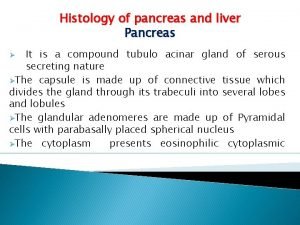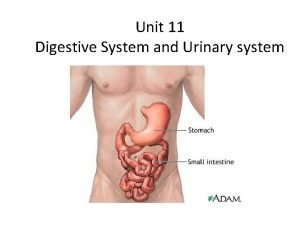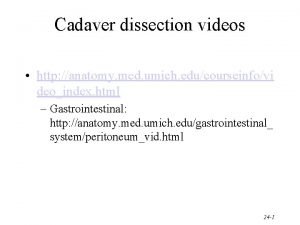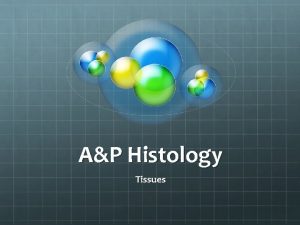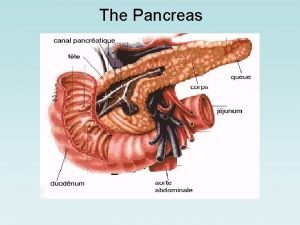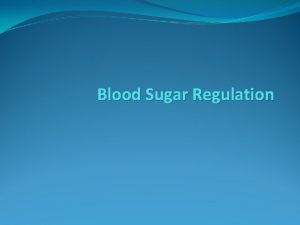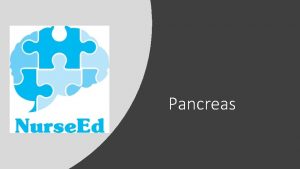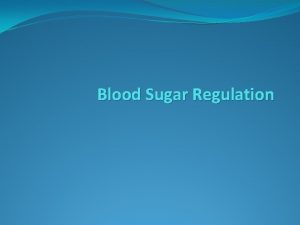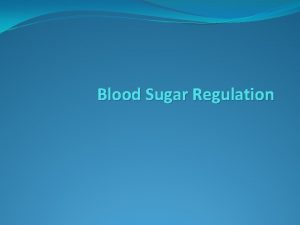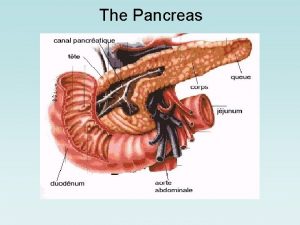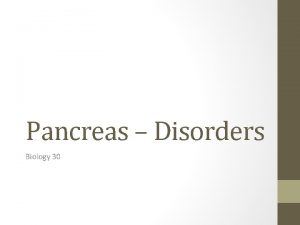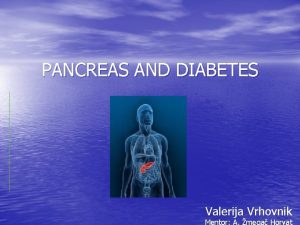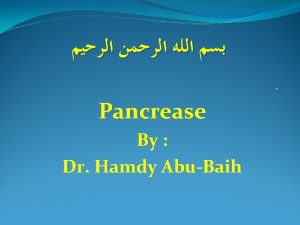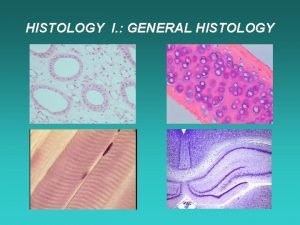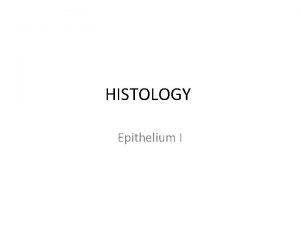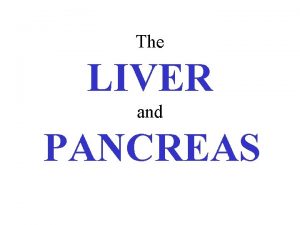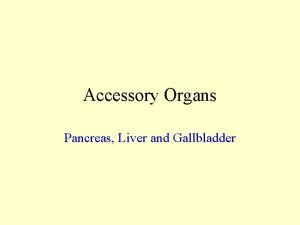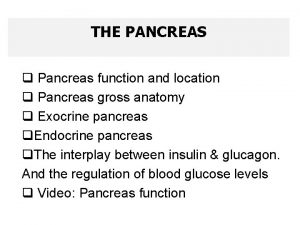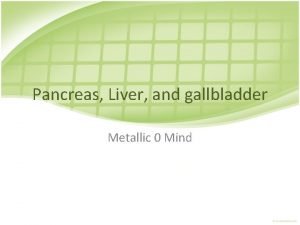Pancreas Anatomy Histology And Physiology Anatomy Histology Physiology

























- Slides: 25

Pancreas Anatomy, Histology And Physiology.

Anatomy:

Histology:

Physiology: -Insulin & energy abundance. -Energy trapper. -Short term glucose regulation, minute to minute along with Glucagon. - -cells of the Islets of Langerhans secrete insulin and amylin.

Chemical composition:

Insulin receptor:

Effect of insulin: uptake of glucose by muscle cells.

Effect of insulin: Hepatocytes -Think the way insulin does! Activate enzymes that trap glucose and synthesize glycogen and inhibit those that degrade glycogen.

-Glucokinase -Glycogen phosphorylase -Glycogen synthase The net effect: Increase the amount of glucose in the liver.

The liver can store up to 100 g of glycogen, then what ? ? ?

Effect of insulin: Adipocytes -Inhibit hormone-sensitive lipase. -Enhance glucose uptake.

Insulin deficiency >>> -Beta oxidation of FA to form Acetyl co. A. -Conversion of acetyl co. A to hydroxybutyric acid, acetoacetic acid (ketosis) and acetone(characteristic breath smell)

Effect of insulin: protein metabolism -Stimulates uptake of amino acids(like GH) -Increases m. RNA translation. -Increase transcription of certain DNA sequences. -Spare proteins and depress the rate of gluconeogenesis.

Insulin and GH: synergism

Mechanism of secretion:

Factors affecting insulin secretion: Increase insulin secretion: - Glucose. - amino acid. - FA. - GI hormones. - GH, cortisol and glucagon. -Insulin resistance and obesity. -Parasympathetic stimulation of G cells. Decrease insulin secretion: - Glucose. -Fasting. -Leptin -Alpha- adrenergic stimulation.

Glucagon - Glycogenolysis through activating the enzyme phosphorylase b, c. AMP pathway, leading to glycogen cleavage. -gluconeogenesis. -adipose cell lipase -ketogenesis

Why is it so important to regulate glucose levels? ? ?

-Glucose>>large amount of osmotic pressure>>dehydration. -Glycosuria. -Osmotic diuresis and loss of water and electrolytes. -Tissue damage (vascular, peripheral neuropathy etc).

Diabetes Mellitus

Diabetes mellitus is defined as a syndrome of impaired carbohydrate, fat, and protein metabolism caused by either lack of insulin secretion or decreased sensitivity of the tissues to insulin.

Diabetes mellitus: -Type I diabetes: insulin-dependant, juvenile. -Type II diabetes: Insulin resistance, adulthood.

Type I vs Type II

Some numbers: -The fasting blood glucose>>8090 mg/ml. -50 -70 mg/ml excitability of the CNS. -20 -50 mg/ml seizures>>coma. -Glucose threshold in urine 180 mg/ml.

 Anatomy and physiology of diabetes
Anatomy and physiology of diabetes Pancreas anatomy and physiology
Pancreas anatomy and physiology Pancreasitis
Pancreasitis Lamina propria of tongue
Lamina propria of tongue Radiologix verdun
Radiologix verdun Gastric glands
Gastric glands Pancreas anatomy
Pancreas anatomy Cadaver stomach labeled
Cadaver stomach labeled Liver histology
Liver histology Upper respiratory labeled
Upper respiratory labeled Tattoo anatomy and physiology
Tattoo anatomy and physiology International anatomy olympiad
International anatomy olympiad Imperfect flowers examples
Imperfect flowers examples Anatomy and physiology of bone
Anatomy and physiology of bone Anatomy and physiology of peptic ulcer ppt
Anatomy and physiology of peptic ulcer ppt Liver physiology and anatomy
Liver physiology and anatomy Epigastric region
Epigastric region Wpigastric region
Wpigastric region Rbc anatomy and physiology
Rbc anatomy and physiology Chapter 14 anatomy and physiology
Chapter 14 anatomy and physiology 3 layers of muscle
3 layers of muscle Http://anatomy and physiology
Http://anatomy and physiology Waistline
Waistline Physiology of appendix
Physiology of appendix Aohs foundations of anatomy and physiology 1
Aohs foundations of anatomy and physiology 1 Aohs foundations of anatomy and physiology 2
Aohs foundations of anatomy and physiology 2


